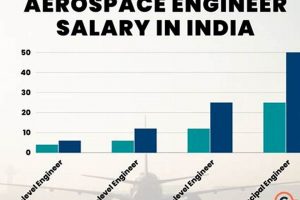The process of pursuing a career path in the field of aeronautics and astronautics involves a combination of rigorous academic training, practical experience, and professional development. This endeavor typically requires a strong foundation in mathematics, physics, and engineering principles. Successful navigation of this path leads to opportunities to design, develop, test, and oversee the manufacturing of aircraft, spacecraft, satellites, and related systems.
Entering this profession offers the potential to contribute significantly to advancements in air and space travel, defense technologies, and scientific exploration. Historically, individuals in this field have played a crucial role in shaping aviation, space exploration, and related technological advancements. The benefits extend beyond personal career fulfillment, impacting societal progress through innovation and problem-solving.
Understanding the educational prerequisites, skill development strategies, and professional opportunities is paramount for individuals considering this vocation. The following sections detail the steps and considerations involved in achieving proficiency and success in this demanding and rewarding career.
Guidance for Aspiring Professionals
The subsequent recommendations are designed to provide clarity and direction for those seeking entry into the aerospace engineering sector. Careful consideration of these points will aid in preparation and career advancement.
Tip 1: Establish a Strong Academic Foundation: Rigorous coursework in mathematics, physics, and computer science is essential. A comprehensive understanding of these subjects forms the bedrock for advanced aerospace engineering concepts.
Tip 2: Pursue a Bachelor’s Degree in a Relevant Field: An accredited bachelor’s degree in aerospace engineering, or a closely related discipline such as mechanical engineering with an aerospace concentration, is generally required. This provides the necessary theoretical knowledge and practical skills.
Tip 3: Seek Internship Opportunities: Gaining practical experience through internships at aerospace companies or research institutions is invaluable. This exposure provides hands-on learning and networking opportunities.
Tip 4: Develop Proficiency in Relevant Software: Familiarity with industry-standard software such as CAD (Computer-Aided Design), FEA (Finite Element Analysis), and CFD (Computational Fluid Dynamics) is crucial for design and analysis tasks.
Tip 5: Consider Advanced Education: A master’s degree or doctorate can provide specialized knowledge and research experience, which may be required for certain roles and advancement opportunities, particularly in research and development.
Tip 6: Obtain Professional Licensure: Becoming a licensed Professional Engineer (PE) demonstrates competency and adherence to ethical standards. Licensure may be required for certain engineering positions, particularly those involving public safety.
Tip 7: Stay Current with Industry Trends: The aerospace industry is constantly evolving. Continuous learning through professional development courses, conferences, and industry publications is essential to stay abreast of new technologies and advancements.
Effective implementation of these strategies will enhance the likelihood of securing a fulfilling and impactful career in aerospace engineering. The commitment to academic rigor, practical experience, and continuous learning is paramount for success.
The subsequent section will provide a comprehensive summary, further solidifying understanding.
1. Education (Accredited Program)
Formal education, specifically completion of an accredited aerospace engineering program, is a foundational prerequisite for a career in this field. Accreditation ensures that the program meets established quality standards, guaranteeing students receive a comprehensive curriculum aligned with industry expectations. The consequence of pursuing a non-accredited program is often limited job prospects and potential difficulties in obtaining professional licensure. The accredited program imparts fundamental knowledge of aerodynamics, propulsion, structures, and control systems, forming the bedrock of subsequent professional practice. For instance, the Accreditation Board for Engineering and Technology (ABET) is a widely recognized accrediting body that evaluates and certifies engineering programs, signifying a standard of quality and rigor.
The importance of this educational component extends beyond theoretical knowledge. Accredited programs typically incorporate hands-on laboratory experiences, design projects, and simulation exercises. These practical components allow students to apply theoretical concepts to real-world problems, developing critical thinking and problem-solving skills. A prime example is the design and construction of a functional aircraft model or the simulation of spacecraft trajectories, activities commonly included in ABET-accredited curricula. The practical skills acquired during such activities enhance graduates’ readiness for immediate contributions within the aerospace industry.
In summary, participation in an accredited aerospace engineering program is a critical and necessary step. Successful completion of such a program not only equips individuals with essential theoretical knowledge and practical skills, but also increases their credibility and marketability within the competitive aerospace sector. The long-term impact includes the capability to innovate, design, and contribute to advancements in air and space technologies, thus shaping the future of aerospace engineering.
2. Mathematical Proficiency
A robust understanding of mathematical principles is indispensable for a career in aerospace engineering. The design, analysis, and operation of aerospace systems rely heavily on mathematical models and calculations. Proficiency in this area directly impacts an individual’s ability to contribute effectively to various aspects of the field.
- Calculus and Differential Equations
These mathematical tools are fundamental for understanding the dynamics of flight, analyzing fluid flow around aircraft, and modeling control systems. For example, differential equations are used to describe the motion of a rocket under the influence of gravity and atmospheric drag. Without a strong grasp of calculus, accurately predicting and controlling the behavior of aerospace vehicles becomes an insurmountable challenge. Failure to properly model these aspects can lead to catastrophic design flaws.
- Linear Algebra
Linear algebra is crucial for solving systems of equations that arise in structural analysis and control system design. Finite element analysis, a common technique for assessing the structural integrity of aircraft components, relies heavily on linear algebra to solve large systems of equations. For instance, determining the stresses within a wing structure under various load conditions requires the application of linear algebra principles. Inadequate understanding can result in structurally unsound designs.
- Probability and Statistics
These branches of mathematics are essential for analyzing experimental data, assessing risk, and ensuring the reliability of aerospace systems. Statistical methods are used to analyze flight test data, determine the probability of component failure, and optimize maintenance schedules. For example, understanding the statistical distribution of wind gusts is critical for designing robust control systems. Misinterpreting statistical data can lead to inaccurate risk assessments and compromised safety.
- Numerical Methods
Many aerospace engineering problems do not have analytical solutions and require numerical approximation techniques. These methods are used extensively in computational fluid dynamics (CFD) simulations, trajectory optimization, and control system design. For example, simulating the flow field around an airfoil using CFD requires the application of numerical methods to solve the Navier-Stokes equations. Limitations in the understanding and application of numerical methods may result in unreliable simulation results and poor design decisions.
Therefore, mastering these mathematical disciplines is not merely an academic exercise, but rather a critical component of “how to become aerospace engineer.” A deficiency in these areas significantly limits an individual’s ability to perform essential engineering tasks, potentially jeopardizing the safety and performance of aerospace systems. The consistent application of mathematical rigor is essential for ensuring the reliability and success of aerospace endeavors.
3. Practical Experience
Practical experience forms a cornerstone of “how to become aerospace engineer,” bridging the gap between theoretical knowledge and real-world application. The correlation between hands-on engagement and professional competency is demonstrably strong. This component of education is not merely supplementary; it is a critical factor in the development of a well-rounded and capable engineer. The acquisition of practical skills directly impacts an individual’s ability to contribute effectively to the design, development, and testing of aerospace systems. Consider, for instance, the student who, through an internship at a propulsion systems manufacturer, gains firsthand experience in the assembly and testing of rocket engines. This individual develops not only technical proficiency but also an understanding of manufacturing processes, quality control, and teamwork, skills not easily replicated in a classroom setting.
The benefits of practical engagement extend beyond the mastery of specific technical skills. Participation in research projects, internships, or co-op programs provides invaluable opportunities to apply engineering principles to solve complex, real-world problems. For example, an engineering student involved in a university-led satellite development project gains experience in systems engineering, project management, and interdisciplinary collaboration. These experiences foster critical thinking, problem-solving abilities, and a sense of professional responsibility. Furthermore, interaction with seasoned professionals in industry settings provides mentorship and guidance, shaping the student’s understanding of industry standards, ethical considerations, and career pathways. Exposure to the daily operations of aerospace companies or research labs fosters realism and a deeper understanding of the profession beyond textbook knowledge.
In summary, the acquisition of practical experience is essential for those who are on “how to become aerospace engineer.” Its impact extends beyond the immediate gain of technical skills, fostering critical thinking, problem-solving acumen, and professional awareness. The absence of such opportunities creates a tangible disadvantage, hindering an individual’s ability to transition successfully from academia to a productive career in the aerospace industry. The industry values experience and application, which creates a demand for professionals who have developed their career through practical means.
4. Software Skills
Proficiency in various software applications is an indispensable component of professional competence for individuals pursuing a career path in aerospace engineering. The design, analysis, simulation, and manufacturing processes within the industry are heavily reliant on specialized software tools. Therefore, the attainment of relevant software skills constitutes a crucial step in “how to become aerospace engineer.”
- CAD (Computer-Aided Design) Software
CAD software, such as CATIA, SolidWorks, or AutoCAD, enables the creation of precise 3D models of aircraft, spacecraft, and their components. These models serve as the foundation for design analysis, manufacturing planning, and documentation. For example, an aerospace engineer might use CATIA to design the wing structure of a new aircraft, meticulously defining its geometry and internal support structures. A working knowledge of CAD tools is essential for visualizing and communicating design concepts, optimizing designs for performance and manufacturability, and ensuring compatibility with other engineering disciplines.
- FEA (Finite Element Analysis) Software
FEA software, such as ANSYS or Abaqus, is used to simulate the behavior of aerospace structures under various loads and environmental conditions. These simulations allow engineers to predict stress concentrations, deformation patterns, and potential failure modes. For instance, FEA software could be used to analyze the stress distribution within a rocket engine nozzle during combustion, identifying areas prone to cracking or fatigue. Competence in FEA allows for virtual testing and optimization of designs, reducing the need for costly physical prototypes and enhancing the reliability and safety of aerospace systems.
- CFD (Computational Fluid Dynamics) Software
CFD software, such as Fluent or OpenFOAM, enables the simulation of fluid flow around aircraft, spacecraft, and other aerospace components. These simulations provide insights into aerodynamic performance, heat transfer, and fluid-structure interaction. For example, CFD software could be used to analyze the airflow around an aircraft wing, determining its lift and drag characteristics at different speeds and angles of attack. Proficiency in CFD is critical for optimizing aerodynamic designs, predicting performance characteristics, and understanding the complex flow phenomena associated with aerospace systems.
- Programming Languages and Scripting
Proficiency in programming languages like Python, MATLAB, or C++ is increasingly valuable in aerospace engineering. These languages are used for data analysis, automation of tasks, development of custom tools, and implementation of control algorithms. For example, Python could be used to analyze large datasets from flight tests, identify trends, and generate reports. A strong understanding of programming enables engineers to automate repetitive tasks, develop customized solutions to specific engineering challenges, and integrate different software tools into a seamless workflow.
The command of these software applications significantly enhances an aerospace engineer’s ability to design, analyze, and optimize complex systems. The investment in developing these skills is therefore a critical element in the “how to become aerospace engineer” and greatly improves career prospects. Mastery of these tools facilitates innovation, enhances productivity, and contributes directly to the development of safer and more efficient aerospace technologies.
5. Professional Development
The pursuit of “how to become aerospace engineer” is not a static endeavor concluded upon graduation; rather, it represents the commencement of a continuous professional development journey. The aerospace sector is characterized by rapid technological advancement and evolving industry standards. Therefore, sustained learning and skill enhancement are essential for maintaining professional relevance and contributing effectively to the field.
Professional development encompasses a range of activities designed to expand knowledge and skills beyond formal education. This can include participation in conferences, workshops, and seminars focused on emerging technologies, such as hypersonic flight or advanced composite materials. Furthermore, pursuing advanced certifications, such as those offered by professional engineering societies, demonstrates a commitment to competence and ethical practice. For instance, an aerospace engineer working on satellite propulsion systems may attend a conference on ion propulsion technology to learn about recent breakthroughs and integrate new techniques into their work. Without a sustained commitment to continuous learning, professionals risk obsolescence in a rapidly evolving environment.
Furthermore, involvement in professional organizations provides access to networking opportunities, mentorship programs, and resources that facilitate career advancement. These activities are critical for staying informed about industry trends, gaining insights from experienced professionals, and building relationships that can lead to new career opportunities. Therefore, professional development is not simply a desirable attribute but a necessary component of “how to become aerospace engineer” in the long term. Failure to engage in such activities limits career growth and potential contributions to the field. By continuously updating skills and knowledge, aerospace engineers can drive innovation, improve system performance, and ensure the safety and reliability of aerospace technologies.
6. Problem-Solving Acumen
Problem-solving acumen constitutes a core attribute within the complex skill set necessary for success in aerospace engineering. The profession inherently involves addressing multifaceted challenges ranging from aerodynamic inefficiencies to structural weaknesses and guidance system malfunctions. A direct correlation exists between an engineer’s problem-solving capabilities and their effectiveness in contributing to the design, development, and maintenance of aerospace systems. For example, the task of mitigating flutter in a newly designed aircraft wing demands a systematic approach involving the identification of contributing factors, the application of relevant aerodynamic and structural principles, and the implementation of effective solutions through design modifications or active control systems. An engineer lacking robust problem-solving skills would be significantly hampered in this endeavor.
The application of problem-solving acumen extends beyond addressing existing issues; it is also crucial for proactive risk mitigation and system optimization. During the design phase of a spacecraft, engineers must anticipate potential challenges related to thermal management, radiation exposure, and micrometeoroid impact. The capacity to analyze potential failure modes, develop contingency plans, and optimize system performance under adverse conditions is paramount. Consider the design of a thermal protection system for a spacecraft re-entering Earth’s atmosphere; engineers must integrate knowledge of heat transfer, material properties, and trajectory dynamics to develop a robust system capable of withstanding extreme temperatures. This iterative process of analysis, design, and testing requires a high degree of problem-solving aptitude.
In summary, problem-solving acumen is not merely a desirable attribute but a fundamental requirement for those who are on “how to become aerospace engineer.” Its presence directly influences an engineer’s capacity to address complex technical challenges, mitigate risks, and optimize system performance. The development of this skill set, through rigorous training and practical experience, is therefore essential for achieving professional competency and contributing to advancements in the aerospace sector. The inherent complexity and criticality of aerospace systems necessitate a commitment to problem-solving excellence at all levels of the profession.
Frequently Asked Questions About Pursuing a Career in Aerospace Engineering
The following section addresses common inquiries and misconceptions related to the pursuit of a career as an aerospace engineer. These questions are answered with the goal of providing clarity and guidance to prospective individuals.
Question 1: Is a graduate degree necessary to secure a position in aerospace engineering?
While a bachelor’s degree in aerospace engineering, or a closely related field, is often sufficient for entry-level positions, a master’s degree or doctorate can provide specialized knowledge and research experience that may be required for certain roles. These positions are often in research, development, and leadership.
Question 2: What are the essential skills beyond technical knowledge required for success in this field?
In addition to technical expertise, effective communication, teamwork, problem-solving, and critical thinking skills are crucial for success. The ability to work collaboratively, articulate ideas clearly, and approach complex challenges with a methodical mindset is highly valued.
Question 3: How important are internships in the pursuit of “how to become aerospace engineer”?
Internships are of paramount importance. They provide practical experience, networking opportunities, and a deeper understanding of the industry. Engaging in multiple internships can significantly enhance job prospects after graduation.
Question 4: What role does professional licensure play in an aerospace engineering career?
Professional licensure, such as obtaining a Professional Engineer (PE) license, demonstrates competency and adherence to ethical standards. Licensure may be required for certain engineering positions, particularly those involving public safety, and can enhance career advancement opportunities.
Question 5: Is it possible to specialize within aerospace engineering, and if so, what are some common areas of specialization?
Specialization is common and often advantageous. Common areas include aerodynamics, propulsion, structures, control systems, and astrodynamics. Focusing on a specific area allows for the development of in-depth expertise and increases competitiveness in certain job markets.
Question 6: How can individuals stay current with the rapidly evolving technologies in the aerospace industry?
Continuous learning is essential. This can be achieved through professional development courses, conferences, industry publications, and participation in professional organizations. Staying abreast of new technologies ensures continued relevance and competitiveness.
In conclusion, aspiring aerospace engineers must prioritize not only formal education but also practical experience, skill development, and continuous learning. A well-rounded approach increases the likelihood of securing a fulfilling and impactful career.
The subsequent section will offer concluding remarks, summarizing key aspects of this comprehensive guide.
Conclusion
The preceding exploration of “how to become aerospace engineer” underscores the multifaceted nature of this career path. Essential elements include a rigorous academic foundation in mathematics and science, attainment of a bachelor’s or advanced degree from an accredited engineering program, practical experience gained through internships and research, proficiency in industry-standard software, and a commitment to continuous professional development. Further, a strong aptitude for problem-solving is paramount.
The demanding nature of this profession requires dedication, perseverance, and a passion for innovation. Individuals committed to these principles will find opportunities to contribute to advancements in air and space travel, defense technologies, and scientific exploration, thereby shaping the future of aerospace engineering. The pursuit of this career path is a long-term investment, yielding significant rewards for those who embrace its challenges.


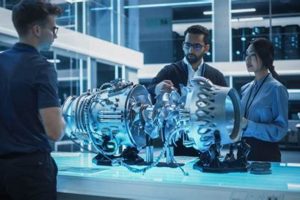
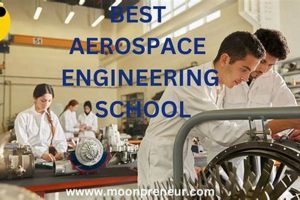
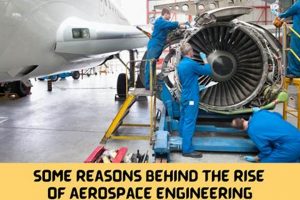
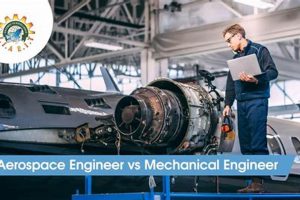
![Top Country for Aerospace Engineering? [A Guide] Innovating the Future of Flight with Reliable Aviation Solutions Top Country for Aerospace Engineering? [A Guide] | Innovating the Future of Flight with Reliable Aviation Solutions](https://mixaerospace.com/wp-content/uploads/2025/11/th-785-300x200.jpg)
